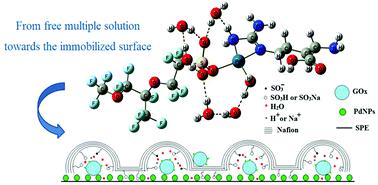Our official English website, www.x-mol.net, welcomes your feedback! (Note: you will need to create a separate account there.)
Mechanistic aspects of functional layer formation in hybrid one-step designed GOx/Nafion/Pd-NPs nanobiosensors
Analyst ( IF 4.2 ) Pub Date : 2021-1-13 , DOI: 10.1039/d0an02429e E. V. Butyrskaya 1, 2, 3, 4 , N. Korkmaz 5, 6, 7, 8, 9 , E. V. Zolotukhina 4, 10, 11 , V. Krasiukova 12, 13, 14 , Y. E. Silina 8, 15, 16, 17, 18
Analyst ( IF 4.2 ) Pub Date : 2021-1-13 , DOI: 10.1039/d0an02429e E. V. Butyrskaya 1, 2, 3, 4 , N. Korkmaz 5, 6, 7, 8, 9 , E. V. Zolotukhina 4, 10, 11 , V. Krasiukova 12, 13, 14 , Y. E. Silina 8, 15, 16, 17, 18
Affiliation

|
Amperometric nanobiosensors are crucial time and cost effective analytical tools for the detection of a wide range of bioanalytes, viz. glucose present in complex environments at very low concentrations. Although the excellent analytical performance of nanobiosensors is undoubted, their exact molecular structure often remains unclear. Here, by combining advanced nanoanalytical approaches with theoretical modeling, we conducted a comprehensive study towards the investigation of the molecular structure of a hybrid GOx/Nafion/Pd-NPs layer deposited by electroplating from the multicomponent electrolyte solution on the surface of screen printed electrodes modified with graphene oxide. Specifically, we revealed that Pd2+ cations were adsorbed on GOx amino acid residues, forming the GOx·nPd2+ enzymatic complex. The highest adsorption energy of Pd2+ cations on GOx was found during their interaction with the side chains of basic amino acids and methionine. In addition, we showed and fully validated the end-structure of the one-step designed GOx/Nafion/Pd-NPs nanobiosensor as a structural model mainly composed of GOx and water molecules incorporated into the metal–polymer scaffold. Our approach will thus serve as a guideline for the study of molecular interactions occurring in complex systems and will contribute to the design of the next generation of hybrid nanobiosensors. The proposed mechanism, driving the self-assembly of the hybrid layer, will allow us to construct modular enzymatic nanoanalytical devices with tailored sequences in the future.
中文翻译:

混合一步设计GOx / Nafion / Pd-NPs纳米生物传感器中功能层形成的机理
安培纳米生物传感器是至关重要的时间和成本效益分析工具,用于检测多种生物分析中,中即。葡萄糖以非常低的浓度存在于复杂的环境中。尽管毫无疑问,纳米生物传感器具有出色的分析性能,但它们的确切分子结构通常仍然不清楚。在这里,通过将先进的纳米分析方法与理论模型相结合,我们对由多组分电解质溶液通过电镀沉积在丝网印刷电极表面的复合GOx / Nafion / Pd-NPs层的分子结构进行了研究。与氧化石墨烯。具体而言,我们发现Pd 2+阳离子被吸附在GOx氨基酸残基上,形成GOx·Ñ钯2+酶复合物。在GOd上Pd 2+阳离子与碱性氨基酸和蛋氨酸的侧链相互作用期间发现了最高的吸附能。此外,我们展示并充分验证了一步设计的GOx / Nafion / Pd-NPs纳米生物传感器的末端结构,该结构为主要由GOx和掺入金属-聚合物支架中的水分子组成的结构模型。因此,我们的方法将作为研究复杂系统中发生的分子相互作用的指南,并将有助于下一代杂交纳米生物传感器的设计。所提出的机制将驱动杂化层的自组装,从而使我们将来能够构建具有定制序列的模块化酶促纳米分析设备。
更新日期:2021-02-10
中文翻译:

混合一步设计GOx / Nafion / Pd-NPs纳米生物传感器中功能层形成的机理
安培纳米生物传感器是至关重要的时间和成本效益分析工具,用于检测多种生物分析中,中即。葡萄糖以非常低的浓度存在于复杂的环境中。尽管毫无疑问,纳米生物传感器具有出色的分析性能,但它们的确切分子结构通常仍然不清楚。在这里,通过将先进的纳米分析方法与理论模型相结合,我们对由多组分电解质溶液通过电镀沉积在丝网印刷电极表面的复合GOx / Nafion / Pd-NPs层的分子结构进行了研究。与氧化石墨烯。具体而言,我们发现Pd 2+阳离子被吸附在GOx氨基酸残基上,形成GOx·Ñ钯2+酶复合物。在GOd上Pd 2+阳离子与碱性氨基酸和蛋氨酸的侧链相互作用期间发现了最高的吸附能。此外,我们展示并充分验证了一步设计的GOx / Nafion / Pd-NPs纳米生物传感器的末端结构,该结构为主要由GOx和掺入金属-聚合物支架中的水分子组成的结构模型。因此,我们的方法将作为研究复杂系统中发生的分子相互作用的指南,并将有助于下一代杂交纳米生物传感器的设计。所提出的机制将驱动杂化层的自组装,从而使我们将来能够构建具有定制序列的模块化酶促纳米分析设备。


























 京公网安备 11010802027423号
京公网安备 11010802027423号